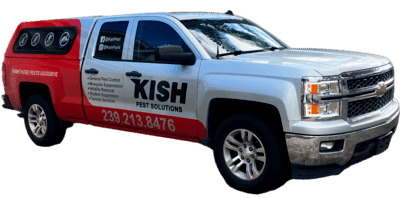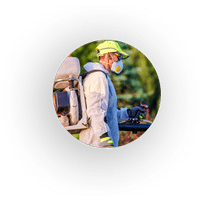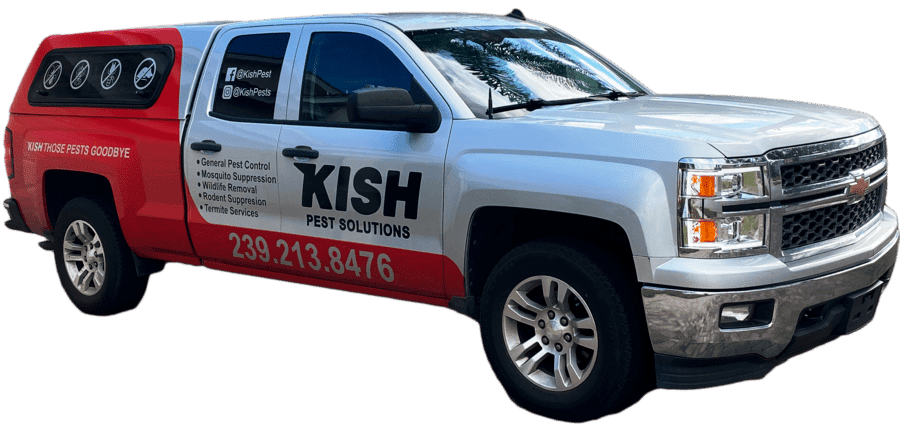Ant Control Naples, FL
Get a free estimate
In-home or at your place of business
Call Out Form

Pest Control Services
Ant Removal in Naples, FL

Chad came by and completely addressed our issues. He was professional and knowledgeable. I would definitely recommend Kish to my neighbors.
It pays to be vigilant against ants. They outnumber us at every turn, so it’s best to defeat them before they harm us, our property, our children, or our pets.
The ant control experts at Kish Pest Control take a proven, multi-pronged approach to help you take back your home or business from an ant infestation.
Ant Control Services
Free Site Inspection
Three-Step Ant Extermination
Free Callbacks
Rat Damage Repair
Ants, like Floridians, thrive in tropical and subtropical settings. They become a nuisance pest when they cause structural damage, contaminate food, and create unsightly mounds in lawns and landscapes. Some species bite. Ant extermination often means using a variety of pest control methods.
Rat Control in Naples and Southwest Florida – What Is It?
Roof rats and Norway rats are the most common, most destructive rodents in Florida. What makes them successful survivors – their adaptability – are what causes humans the most pain. And they reproduce fast!
Rats are widespread, they adapt to human infrastructure, and they love our food and garbage.
They attack important Florida citrus and fruit crops. They damage and contaminate our living spaces. Unfortunately, the diseases they can carry are serious, they’ve got fleas, and the structural damage they cause can be expensive and hard to fix. Most of all, they’re persistent.
We know this: Kish Pest’s rat exterminator calls have been growing in frequency. We know they’re a growing problem. But we can help.
Kish Removes Ants – Serving Naples, Lee County, and Collier County
Free Site Inspection for Your Home or Building
The first step is to understand where the rats are, where they’re coming from, and where they’re likely to go. We thoroughly investigate your interior and exterior:
We identify rat harborage (nesting) sites, runways, and entry points
We identify additional indoor and outdoor hiding spots, such as thick vegetation, debris, or clutter
We find conditions that could support a rat population, such as available food and water
We document where they’ve caused damage
We customize an effective rat control plan that protects non-target people and pets
Free Site Inspection
Understanding the biology and behavior of ants is crucial for successful ant extermination. Your ant exterminator from Kish starts with a thorough investigation of your property. We’ll identify the problem ant species, find where they’re nesting, and what they are using as food sources.
We’ll provide a free, no-obligation written estimate that outlines a custom plan of action, so you know what needs to be done and how much it’ll cost.
Three-Step Ant Extermination
Ant extermination typically involves a combination of chemical treatments and physical barriers. Your targeted ant control program can be summarized in three steps:
- We treat the perimeter of your property with a repellent liquid or granular insecticide to create a barrier against ants.
- We broadcast bait that targets your specific ant problem.
- We treat indoor and outdoor ant harborage sites, including ant mounds and ant trails.
Ant control doesn’t end at extermination. Your customized plan of action may also include post-extermination services such as:
- Sealing entry points to prevent future ant invasions
- Sanitation of areas where food particles might be found
- Moving or removing plants and honeydew-producing insects that attract ants
- Reporting potential harborage sites, such as piles of wood or debris, or moisture sources such as leaks and condensation
Please keep children and pets away from freshly treated areas.
Signs of Rat Infestation
2.
Ant Nests
Ant nests can vary in appearance depending on the species, but they are typically located in soil, cracks, crevices, or hidden areas like wall voids. Look for small mounds of soil, debris, or sawdust-like materials near the nest site. Placing attractive materials, such as jelly, oils, or protein-based substances, can help draw large numbers of ants, allowing you to follow them back to their nest. This method can be particularly effective in locating hard-to-find indoor nests.

If you see live or dead rats during the daytime, call for help immediately
Live rats are proof of rat infestation. If they’re venturing out during the day, it’s typically because there is a very large population in need of food. You’ll need professional tools and tactics to handle rat control.
If dead rats are visible, your rat exterminator will determine if there is disease, poisoning, or other reason. They’ll suggest a course of action depending on what they find.

Pharaoh Ants
Yellowish ants are known for their ability to infest buildings. They seek warm, dark, and moist places.

White-Footed Ants
Small brown or reddish-brown ants with distinctive pale-colored feet. They form large, interconnected colonies with multiple queens.

Ghost Ants
Tiny, pale-colored ants that can be difficult to see. Often found in kitchens and bathrooms.

Carpenter Ants
Large black ants are known for their ability to build nests in wood. They can cause structural damage to buildings and homes.

Rover Ants
Named for their characteristic behavior of quickly moving or “roving” around when foraging for food. Particularly common in urban areas, where they effectively invade homes due to their adaptable nature and tendency to form multiple satellite colonies.

Fire Ants (both native and imported)
Aggressive red ants that can deliver a painful sting. They swarm and can deliver multiple stings. Their mounds can damage lawns, gardens, and landscapes, often disrupting agricultural operations.

Thief Ants

Big-headed Ants, or Pyramid Ants
Named for their distinct pyramid-shaped mounds that they construct in sandy soil. Known for their aggressive behavior, swarming to defend their nests and displaying territorial tendencies.
What to expect when you call Kish
To start getting ant control services today, contact us to set up the time and date of your initial visit. Then you’ll be on your way to a rat-free home or building:


Free Inspection and Free Estimate
We’ll investigate your property to identify problem sites where ants are, or where they’re likely to be. We’ll provide you with a free written estimate that includes a plan of action and a breakdown of cost.


Frequently Asked Questions
Ant Baits: Ant baits are an effective way to deliver toxicants directly to the nest. Baits exploit the foraging and nestmate feeding behaviors of ants, ensuring that the toxicant is distributed throughout the colony, including the queen and brood. Baits are available in various forms, such as granules, liquids, gels, and tamper-resistant containers.
Residual Insecticide Sprays: Residual insecticide sprays can provide temporary relief from invading ants by creating a chemical barrier around your home. Ants that cross the barrier will eventually die, preventing further infestations. However, these sprays do not address the root cause of the problem – the ant nest.
Granular and Gel Baits: Granular baits can be useful for treating large areas, while gel baits are effective crack-and-crevice treatments. Granular baits can be broadcast in the landscape or used as individual mound treatments, while gel baits are ideal for targeting specific indoor ant trails.
Regular ant control measures, including seeking help from an exterminator when needed, can help keep your property free of pests and protect your health and safety.
You’re probably thinking of the sweet melon, but when ant control experts refer to honeydew, they’re likely referring to a kind of insect secretion. Ants have a mutualistic relationship with certain insects, such as aphids and scale insects, that excrete excess sugars as honeydew. Ants protect these insects from predators and parasites, and in exchange, are rewarded with access to the sugar-rich secretions on the insects’ bodies. The ants feed on the honeydew as a source of energy and nutrients. Sometimes they’ll even move aphids and other insects to new feeding locations so they eat more plant sap and produce more honeydew.
Frass is waste produced by insects, particularly wood-boring insects like termites or carpenter ants. It consists of digested wood fibers, excrement, and other debris. Frass often resembles sawdust or small, granular particles and is typically found near the entrance or exit holes of infested wood or in the vicinity of insect activity. The presence of frass can be a sign of an active infestation and is commonly used as a diagnostic indicator by pest control professionals to identify wood-damaging insect activity.
Many ant species bite as a form of defense, such as fire ants, bullet ants, army ants, harvester ants, and bulldog ants. In Southwest Florida, fire ants are the most likely source of painful, burning ant bites. They tend to swarm, and their stings leave painful, itchy welts that can last hours or days.
Severe allergic reactions to ant bites require emergency medical care.
Allergic or systemic reactions include intense itching, hives (urticaria), flushed or pale skin, dizziness, nausea, difficulty breathing, and swelling in the face, lips, tongue, or throat. Severe reactions can lead to anaphylaxis, a potentially life-threatening allergic reaction that requires immediate medical attention.
Cleanliness and Sanitation: Keep your home clean and free of food crumbs and spills, Wipe down surfaces regularly, store food in airtight containers, and promptly clean up any spills.
Vinegar: Mix equal parts white vinegar and water in a spray bottle and spray it along ant trails, entry points, and areas where they gather. Repeat this daily to deter ants.
Citrus Peels: Save and place citrus peels, such as those from lemons or oranges, near ant entry points, windowsills, or other areas of ant activity. The strong scent can help repel ants.
Cinnamon: Sprinkle cinnamon powder near entry points and areas where ants are seen. Ants dislike the smell of cinnamon and will try to avoid it.
Borax and Sugar Bait: Create a bait using a mixture of equal parts borax and sugar. Place small amounts of the mixture in shallow dishes or along ant trails. The ants will be attracted to the sugar but will carry the borax back to the colony, ultimately affecting their population.
Peppermint Oil: Mix a few drops of peppermint oil with water and spray it in areas where ants are present or along their trails.
Learn More About Ants and Ant Control in SW Florida
Ant Social Structure and Life Cycle
Ants are social insects, with colonies consisting of workers (sterile females), queens (reproductive females), and males. Workers perform various tasks, including constructing and defending the nest, feeding the colony members, and foraging for food and water. Queens are responsible for reproduction and can live for many years. Males, on the other hand, have a sole purpose of mating with the queen and die shortly after.
Ants undergo a four-stage life cycle: egg, larva, pupa, and adult. Worker ants feed the larvae, which then molt into pupae. Pupae eventually emerge as adult ants, and the colony continues to grow in size and numbers.
Foraging Behavior and Food Preferences
Ants have diverse food preferences They seek a variety of food sources including sweet substances like honeydew (a sugar-rich substance secreted by insects), proteins, oils, seeds, and insects. Scouts locate food sources and leave pheromone trails, which other ants follow to the food source. To find water, ants will travel considerable distances if necessary.
Visit our Knowledge Base for more information about ants





